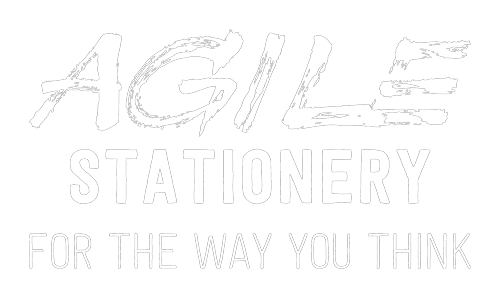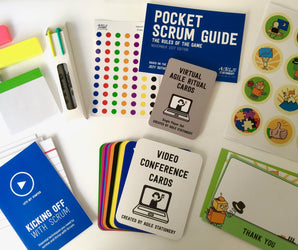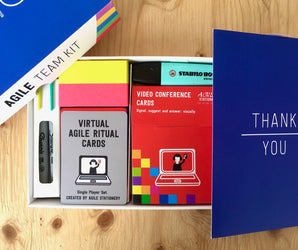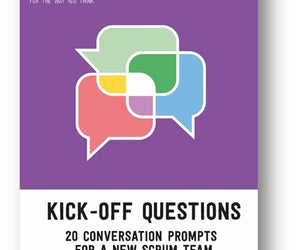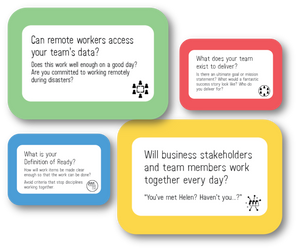It is fair to say that video calling has become a staple part of our workplace experience during this lockdown. It's like turnips. They are fine as long as they are on a plate with a bunch of other things. In lockdown though, it feels like all we have is the video calling variety of common turnip.
Obviously, what is missing is the rich luxurious gravy of face to face communication, but also a bunch of other ingredients. Face to face is clearly out of the question for the time being. All we can do is stay at home. So let's focus on the other missing ingredients:
Meaningful Decoration
Setting up a space is about more than desks and chairs. Colour and materials express the values of the company we work for, while the team we work in also influences the space. It is quite common to see simple DIY signage, posters and a range of knick-knacks and amusing printed items placed around a team area. These objects establish a sense of place and of belonging.
At home, we belong to our homes. The team and the company seem less real.
Information Radiators
Well-liked in the agile coaching and software delivery communities information radiators are a display of information or data that is attached to a vertical surface and used to push or radiate information into a collaborative space. The idea is that it is consulted many times a day ad-hoc, or even accidentally.
Kanban boards show the amount of work in progress and the available inventory of ready & analysed work. Burn down charts show us whether we are going to be able to deliver on time.
All of these things, while sometimes aesthetically pleasing, are utilitarian things designed to enable decisions. They are also shared, agreed-upon objects and are often quite large. In the home, they are entirely missing and all information needs to be dredged up on-demand on a single user's screen.
Embodied Cognition
This is the unspoken focus of the stationery trade, particularly the office stationery market where items are designed to be used by a team. The concept here is that our mental problem-solving efforts are supported by the things we create and organise in the world.
A simple collection of sticky notes has a surprising richness of information coded into it. Authors use colour to create categories, and position them according to status or similarity, perhaps using position to create intersecting, complementary or new categorisations. Once we have encoded this information into our shared environment - a whiteboard or a table top - it can become the focus of cognition for team mates who can spot patterns or make new connections.
The result is a tight low-latency feedback loop that brings fresh insights, combines diverse perspectives and often drives forward a problem solving effort in a way that is so effective and efficient that its absence is a serious issue.
Fortunately this is an area where there is a great deal of support available from tools. The question is, are they as good as the real thing?
Body Language
Body language is well-known as a source of clues about the emotions and character of your colleagues. This is true, but it is also used in more practical ways. When we say that we “can’t get a word in edgewise” we mean that we are finding it difficult to communicate the fact that we wish to speak, often because those already speaking are not looking at our body language.
Video calls usually cut the body in half and can even hide the top half if they are not well configured or users don’t know how to bring up the larger thumbnail view.
We have developed a set to cards designed to be shown on video call screens. Compared to body language they lack subtlety - like flirting by Bat Signal - but they achieve cut-through in a crowded screen full of thumbnails.
What they also do is replace the visual nature of body language which can signal a need - such as to hurry up, or slow down, or a need to speak - without needing to speak. This is more subtle than alternatives as it allows for a need to be signalled asynchronously by video allowing the user's peers to continue speaking on the audio until they are ready to process the new signal.
Chance Encounters
When Iwan is walking to the kitchen and I am walking back to my desk we will cross paths. If there is something on Iwan's mind he will stop me and ask about it. Some people do this more than others, but the benefit is obvious. There is probably something on the person's mind and seeing the other person, they see the opportunity to make progress. Such things often lead to a change in the way projects and lives proceed and as long as they involve an exchange of information the change is usually for the better.
People often invest in offices to generate this kind of encounter. Architects optimise floor plans to ensure they happen and have developed complex algorithms to predict the results. There is no equivalent strategy, that I am aware of, for generating unplanned encounters online.
Accidental Conversations
Except perhaps there is. Even if people have made a plan to meet, some of the benefit of unplanned meetings is present when there are unplanned changes of topic. The virtual team pub-meeting when someone shares an interesting email that just popped up on their screens is an example.
Unplanned topic-changes often happen in real life because a physical object. Perhaps some shared cognition, like those post-its we discussed above, or a prompt card, or a nearby visualisation of some data.
Through the Agile Games Workshop we'll be experimenting with ways to deliberately re-introduce physical objects even if there is a cost involved, to try to recapture the benefits of this.
